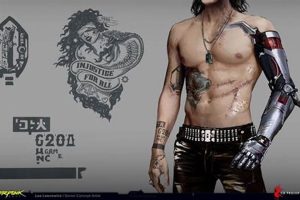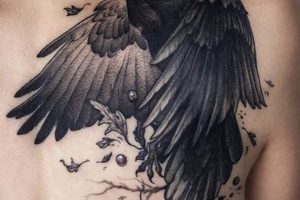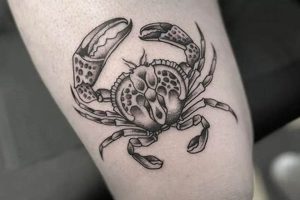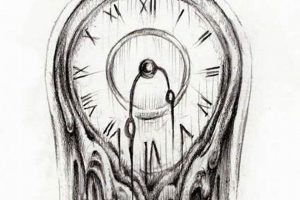Small, simple designs characterized by clean lines, delicate details, and often monochromatic palettes define this popular tattoo aesthetic. Examples include geometric shapes, single-line drawings of objects or animals, and short textual phrases. These tattoos prioritize impactful visuals with minimal elements.
The enduring appeal of this style lies in its subtlety and versatility. These tattoos can be easily concealed or displayed, making them suitable for diverse lifestyles and professions. Their understated elegance allows for personal expression without overwhelming the wearer’s overall appearance. Furthermore, smaller designs generally require less time and expense, and the simplified aesthetic can age gracefully over time.
This aesthetic lends itself well to various themes and placements, offering a broad spectrum of creative possibilities. The following sections will explore popular design elements, placement considerations, and aftercare tips for those considering this approach to body art.
1. Concept
A strong concept forms the foundation of successful minimalist tattoos. It provides the central idea, guiding aesthetic choices and ensuring the design resonates with the wearer’s intentions. Conceptual clarity is paramount in a style that prioritizes simplicity and impactful visuals.
- Simplicity:
Minimalism thrives on reduction. Distilling a concept to its essence is crucial. Rather than depicting a detailed floral bouquet, a single stem or leaf can evoke a sense of natural beauty with greater impact. This focus on essential elements allows the core idea to shine through without unnecessary embellishments.
- Meaning:
While simple in form, minimalist tattoos often carry deep personal meaning. A small symbol, geometric shape, or short word can represent a significant life event, belief, or relationship. A semicolon, for instance, has become a widely recognized symbol of hope and resilience in mental health awareness. The chosen imagery should resonate deeply with the individual.
- Inspiration:
Inspiration can be drawn from numerous sources: nature, geometry, personal experiences, or abstract concepts. Observing the natural world can lead to designs based on the silhouette of a bird in flight or the delicate curve of a shell. Geometric patterns offer another rich source of inspiration, providing structure and symmetry.
- Visual Metaphor:
Minimalist tattoos frequently employ visual metaphors to convey complex ideas succinctly. A mountain range can represent resilience, a compass can symbolize guidance, or a single line can represent a life journey. These visual metaphors add layers of meaning without compromising the minimalist aesthetic.
By carefully considering these facets of concept development, individuals can ensure their minimalist tattoo is not only visually appealing but also carries a lasting, personal significance. The interplay of simplicity, meaning, inspiration, and visual metaphor allows for a powerful expression of self through a refined and understated aesthetic.
2. Placement
Placement is integral to the overall impact of minimalist tattoos. The chosen location on the body significantly influences how the design is perceived and how it interacts with the wearer’s form. Consideration of body contours, visibility preferences, and the potential for future additions are crucial aspects of placement strategy.
The human body offers a diverse canvas, each area presenting unique characteristics for tattoo placement. Smaller minimalist designs, such as a delicate floral stem or a geometric symbol, can be subtly placed behind the ear, on the inner wrist, or along the collarbone. These placements offer a sense of intimacy and can be easily concealed if desired. Larger, yet still minimalist, pieces, like a single-line drawing extending along the forearm or a series of small dots tracing the spine, utilize the body’s natural lines to create a flowing, harmonious effect. Rib cage placements offer a discreet yet impactful option, while ankle and foot tattoos provide opportunities for personal expression that can be easily covered or displayed depending on footwear choices.
Effective placement enhances the aesthetic appeal of minimalist tattoos. A small, symbolic design placed on the inner wrist can appear delicate and personal, while a geometric pattern encircling the ankle can create a sense of balance and symmetry. Understanding the interplay between design and placement allows for a cohesive and impactful presentation of the chosen artwork. Furthermore, thoughtful placement considers the potential for future additions, allowing for a curated collection of minimalist tattoos that complement each other over time. Careful consideration of these factors ensures that the chosen design integrates seamlessly with the individual’s body and personal style.
3. Linework
Linework forms the backbone of minimalist tattoo aesthetics. Its precision and clarity are paramount, given the style’s emphasis on simplicity. The quality of linework directly impacts the overall visual impact and longevity of the tattoo. Fine, crisp lines create an elegant, understated appearance, while bolder lines offer a stronger, more graphic statement. Variations in line weight can add depth and dimension even within a minimalist framework. A single, continuous line drawing a simple outline, for instance, exemplifies the style’s reliance on precise execution. Similarly, a series of fine lines creating a geometric pattern demonstrates how variations in weight and spacing can contribute to visual interest without sacrificing the core principle of minimalism. The artist’s skill in executing clean, consistent lines is fundamental to the success of the design.
Several techniques contribute to effective linework in minimalist tattoos. Single-needle techniques are frequently employed to create fine, detailed lines, ideal for delicate designs and small-scale elements. These techniques allow for intricate detailing and precise execution, contributing to the overall refinement of the tattoo. Alternatively, thicker lines, achieved using larger needle groupings, can create bold, graphic statements, even within a minimalist framework. This approach can be particularly effective for geometric designs or abstract shapes, where clean, defined edges are crucial. The choice of technique depends on the specific design and the desired aesthetic effect. Skilled artists can also manipulate line weight to create subtle shading and depth, adding another layer of visual interest without compromising the minimalist aesthetic. This mastery of line control allows for nuanced expression within the constraints of the style.
Successful minimalist tattoos depend heavily on precise, well-executed linework. This precision not only contributes to the immediate visual appeal but also affects the tattoo’s long-term appearance. Clean lines age more gracefully, maintaining their definition over time, while poorly executed lines can blur and lose clarity. Therefore, choosing a skilled artist with a demonstrable mastery of linework is essential for achieving a minimalist tattoo that remains visually compelling for years to come. The enduring quality of well-executed linework underscores its significance within the minimalist tattoo aesthetic, highlighting the symbiotic relationship between technical skill and artistic vision.
4. Symbolism
Symbolism plays a crucial role in minimalist tattoo designs. The inherent simplicity of the style necessitates a reliance on imagery that conveys significant meaning with minimal visual elements. A small symbol can hold profound personal significance, encapsulating complex ideas or experiences in a concise and impactful manner. This section explores key facets of symbolism within minimalist tattooing.
- Cultural Symbols:
Drawing from various cultures offers a rich source of symbolic imagery. An ankh, originating from ancient Egypt, represents life and eternity. The Om symbol from Hinduism and Buddhism signifies the universe and ultimate reality. These symbols, often rendered in simple lines and shapes, carry centuries of meaning and can resonate deeply with individuals who connect with those cultural traditions. Their concise forms lend themselves perfectly to the minimalist aesthetic.
- Natural Elements:
Representations of nature frequently appear in minimalist tattoos. A wave can symbolize the ebb and flow of life, a mountain can represent resilience and strength, and a feather can signify freedom and spirituality. These natural elements, often stylized into simple lines and silhouettes, evoke a connection to the natural world and its inherent symbolism. Their organic forms can be easily adapted to the minimalist style, allowing for powerful imagery with minimal detail.
- Geometric Shapes:
Geometric shapes offer a powerful yet abstract form of symbolism. A triangle can represent strength and stability, a circle can signify wholeness and eternity, and a spiral can symbolize growth and transformation. These shapes, often tattooed in simple black ink, can be combined and arranged to create intricate patterns that hold symbolic meaning for the wearer. Their inherent simplicity aligns perfectly with the minimalist aesthetic.
- Personal Meanings:
Minimalist tattoos often incorporate symbols with deeply personal meanings. A small, unassuming image might represent a significant life event, a cherished memory, or a loved one. A single word, a meaningful date, or a small, abstract design can hold profound significance for the individual, serving as a constant reminder of something deeply personal. The minimalist style allows for these personal symbols to be discreetly displayed yet remain powerfully evocative.
The effectiveness of minimalist tattoos hinges on the careful selection and execution of symbolic imagery. By distilling complex ideas and experiences into simple, impactful visuals, these tattoos can convey profound meaning with minimal elements. The interplay of cultural, natural, geometric, and personal symbols allows for a rich and nuanced form of self-expression within the minimalist aesthetic, demonstrating the power of symbolism in concise and elegant designs.
5. Palette
Palette selection significantly impacts the aesthetic and longevity of minimalist tattoos. The restrained use of color, often limited to black ink, is a defining characteristic of the style. This conscious limitation enhances the impact of the design and allows the linework and concept to take center stage. While black ink remains the dominant choice, exploring variations and judicious use of other colors can further enhance the minimalist aesthetic.
- Black Ink:
The prevalence of black ink in minimalist tattoos stems from its versatility and timeless quality. It provides strong contrast against the skin, ensuring the design remains clear and visible. Black ink also ages well, maintaining its richness and definition over time. A simple black line drawing of a bird or a geometric pattern exemplifies the power and elegance of this classic choice. Its stark simplicity further emphasizes the core elements of the design.
- Limited Color Palettes:
While black ink dominates, minimalist tattoos can incorporate limited color palettes to enhance specific design elements. A small splash of red in a floral design or a touch of blue in a wave tattoo can add a subtle yet impactful layer of meaning. However, restraint is key; the limited palette should complement, not overwhelm, the minimalist aesthetic. A single red heart alongside a black line drawing, for instance, can create a focal point without disrupting the overall simplicity.
- Watercolor Effects:
The watercolor technique, though more complex, can be adapted to suit the minimalist aesthetic. Diluted inks create a soft, diffused effect, reminiscent of watercolor paintings. This technique can be used to add a subtle wash of color behind a minimalist line drawing, creating a sense of depth and atmosphere. A faint watercolor wash behind a simple outline of a flower can add a touch of ethereal beauty without compromising the minimalist principles.
- Skin Tone Considerations:
Palette choices should always consider the individual’s skin tone. Certain colors may appear more vibrant or subtle depending on the skin’s undertones. Black ink generally works well on all skin tones, but lighter colors may be less visible on darker skin. Consulting with a skilled tattoo artist is crucial to determine the optimal palette for a given design and skin tone. A skilled artist can guide the selection process, ensuring the chosen colors complement the individual’s complexion and enhance the overall aesthetic of the tattoo.
Palette selection is an integral aspect of minimalist tattoo design. The considered use of color, whether adhering to the classic black ink approach or incorporating a limited palette, significantly impacts the final result. Careful consideration of skin tone and desired aesthetic ensures the chosen palette enhances the design’s longevity and overall visual impact, contributing to the enduring appeal of the minimalist tattoo. This thoughtful approach to color reinforces the core principles of minimalism, demonstrating that restraint and intentionality can create powerful and lasting artistic statements.
Tips for Choosing Minimalist Tattoos
Careful planning ensures a minimalist tattoo remains aesthetically pleasing and personally meaningful. Consideration of design elements, artist selection, and aftercare practices contributes to a successful and satisfying outcome.
Tip 1: Research Artists: Thorough research is essential. Seek artists specializing in fine linework and minimalist aesthetics. Examine portfolios for examples of clean, precise lines and a consistent style.
Tip 2: Prioritize Simplicity: Less is more. Resist the urge to overcomplicate the design. A single, well-executed element often holds more impact than a cluster of small details.
Tip 3: Consider Placement Carefully: Placement impacts visibility and how the design interacts with the body. Consider body contours and future tattoo plans when choosing a location.
Tip 4: Reflect on Personal Meaning: A minimalist tattoo, though small, should hold personal significance. Choose imagery or text that resonates deeply and reflects individual values or experiences.
Tip 5: Choose High-Quality Ink: Opt for high-quality, professional-grade inks to ensure vibrant, long-lasting color and prevent fading or blurring over time.
Tip 6: Discuss Design with the Artist: Open communication with the artist is crucial. Discuss design ideas, placement options, and any concerns before committing to the tattoo.
Tip 7: Adhere to Aftercare Instructions: Proper aftercare is vital for healing and preserving the tattoo’s quality. Follow the artist’s instructions diligently to minimize the risk of infection or fading.
By following these guidelines, individuals can ensure a positive and fulfilling experience, resulting in a minimalist tattoo that remains a source of personal expression and aesthetic satisfaction for years to come. These considerations contribute to a well-executed and meaningful piece of body art.
The enduring appeal of minimalist tattoos lies in their subtle elegance and powerful symbolism. By embracing simplicity and focusing on essential elements, these designs offer a timeless form of self-expression.
Frequently Asked Questions
This section addresses common inquiries regarding minimalist tattoos, providing concise and informative responses to facilitate informed decision-making.
Question 1: How long do minimalist tattoos typically take?
Duration varies depending on size and complexity. Simpler designs might require as little as thirty minutes, while more intricate pieces can take several hours. Consultation with the chosen artist provides a more accurate time estimate.
Question 2: Are minimalist tattoos less painful than larger tattoos?
Generally, smaller tattoos involve less pain due to reduced surface area and shorter application time. However, pain tolerance varies significantly among individuals. Placement also influences pain levels; areas with thinner skin or closer proximity to bone tend to be more sensitive.
Question 3: Do minimalist tattoos age well?
With proper care and high-quality ink, minimalist tattoos generally age well. Simpler designs with clean lines tend to hold their definition over time. However, all tattoos are subject to some degree of fading and blurring with age. Choosing a skilled artist specializing in fine linework is crucial for maximizing longevity.
Question 4: How much do minimalist tattoos typically cost?
Cost depends on factors such as size, complexity, artist experience, and studio location. Smaller, simpler designs typically cost less than larger, more intricate pieces. It is advisable to consult with potential artists to obtain accurate pricing information.
Question 5: Can minimalist tattoos be easily covered up if needed?
Due to their smaller size and often subtle placement, minimalist tattoos can be relatively easy to conceal with clothing, makeup, or accessories. However, complete cover-up might be challenging depending on the design and location. Laser removal remains an option for those seeking complete removal.
Question 6: What are the key considerations for aftercare?
Proper aftercare is essential for healing and longevity. Following the artist’s specific instructions is crucial. General aftercare guidelines include keeping the tattoo clean and moisturized, avoiding excessive sun exposure, and refraining from picking or scratching the tattooed area. Diligent aftercare promotes optimal healing and preserves the tattoo’s quality.
Careful consideration of these frequently asked questions contributes to informed decisions and realistic expectations regarding minimalist tattoos. Understanding the process, costs, and aftercare requirements allows individuals to approach this form of body art with confidence.
The subsequent section offers a visual gallery of minimalist tattoo designs, providing inspiration and further insight into the diverse possibilities within this popular aesthetic.
Conclusion
Minimalist tattoo designs offer a powerful means of self-expression through carefully chosen imagery and precise execution. Emphasis on simplicity, clean lines, and symbolic meaning allows for impactful visuals that resonate deeply with the wearer. Placement, linework, symbolism, and palette selection are crucial considerations that contribute to the overall aesthetic and longevity of these understated yet compelling designs.
The enduring popularity of minimalist tattoos reflects a broader cultural appreciation for understated elegance and meaningful symbolism. This approach to body art empowers individuals to communicate personal narratives through carefully curated and aesthetically refined designs, demonstrating that powerful statements can be made with minimal elements. The potential for creativity within this style remains vast, offering continued exploration and evolution within the realm of body art.







